What is the Dihedral Effect?
The dihedral effect represents a fundamental aerodynamic phenomenon that plays a vital role for aircraft stability. Picture this: when an aircraft encounters sideslip—where the relative wind approaches from the side—it naturally generates a stabilizing rolling moment that works to restore level flight.
Engineers measure this effect’s potency by examining how much roll moment an aircraft produces relative to each degree of sideslip it experiences.
Causes of Dihedral in Aircraft
Multiple elements work together to create the dihedral effect:
-
Geometric Dihedral: The visible upward angle of the wings. During a sideslip, the windward (leading) wing experiences a higher angle of attack relative to the airflow, generating more lift and creating a rolling moment that levels the aircraft.
-
Wing Sweep: Swept-back wings naturally produce a dihedral effect. During a sideslip, the leading wing experiences a higher effective airspeed across its span than the trailing wing, creating a lift imbalance that results in a stabilizing roll.
-
Wing-Fuselage Interaction: In a high-wing design, the fuselage can block some airflow from the lower wing during a sideslip, reducing its lift and contributing to a roll. The position of the wing relative to the fuselage also influences the overall effect.
-
Vertical Tail: The vertical tail is typically positioned above the aircraft’s center of gravity. The force it generates during a sideslip creates a rolling moment that adds to the dihedral effect.
Effects of Dihedral Angle on Aircraft Performance
The dihedral angle significantly affects an aircraft’s lateral stability and handling personality.
Here’s the fundamental trade-off: increasing dihedral improves stability but reduces roll rate and maneuverability.
The angle also shapes crosswind handling behavior—aircraft naturally bank into the wind, demanding pilot correction to maintain level flight.
Aircraft designers balance competing demands, carefully adjusting dihedral angles to match each aircraft’s mission profile.
Dihedral Effect in Different Aircraft Types
The dihedral effect appears in nearly every aircraft design, though its execution varies dramatically based on intended purpose and design philosophy.
General aviation workhorses like the Cessna 172 feature noticeable dihedral to enhance stability, creating forgiving flight characteristics that make them perfect for pilot training and personal transportation.
In contrast, aerobatic aircraft and fighters—they deliberately embrace minimal dihedral or even cathedral (wings angled downward) to maximize roll responsiveness.
High-wing aircraft, including rugged bush planes, benefit from a pendulum effect since their center of gravity sits below the wings.
Flying wings and delta-wing aircraft pose fascinating challenges in achieving lateral stability without traditional vertical surfaces.
Understanding the Aerodynamics of Dihedral
When sideslip occurs, the wing facing into the relative wind—the windward wing—encounters airflow striking its undersurface more directly.
This stabilizing effect’s magnitude hinges on several interconnected factors.
Wing positioning relative to the fuselage also shapes the dihedral effect’s character.
Understanding these aerodynamic principles is essential for aircraft designers who must balance stability requirements against competing performance demands.
Practical Implications of Dihedral Effect
One of the most important practical effects is the effect on roll rate and responsiveness.
The dihedral effect also affects crosswind landing techniques in meaningful ways.
For student pilots, aircraft with moderate dihedral angles provide invaluable forgiveness during training.
Aircraft designers must carefully consider the dihedral effect when sizing control surfaces and calibrating response characteristics.
Understanding the dihedral effect also helps pilots to anticipate aircraft behavior during unusual flight conditions.

